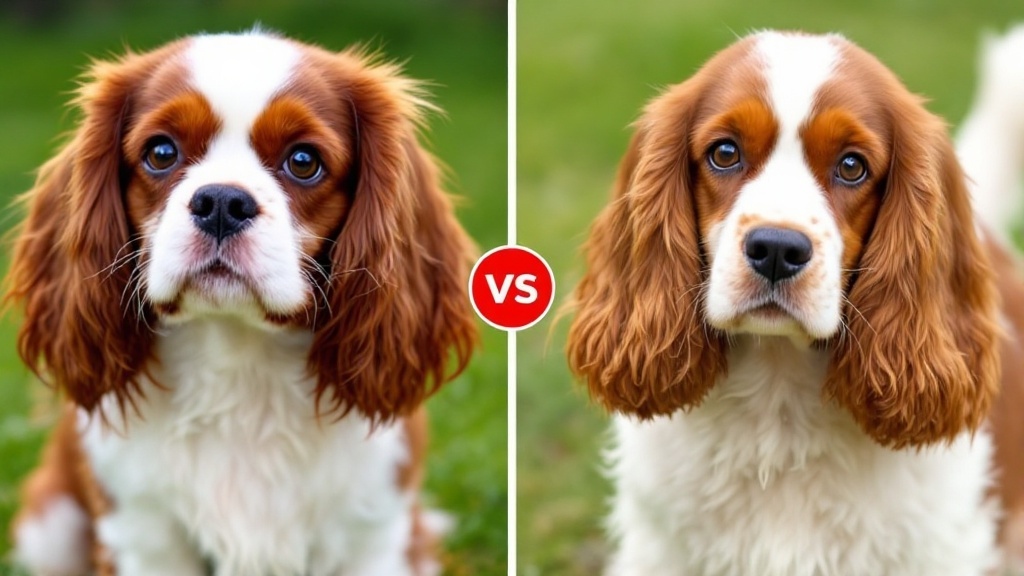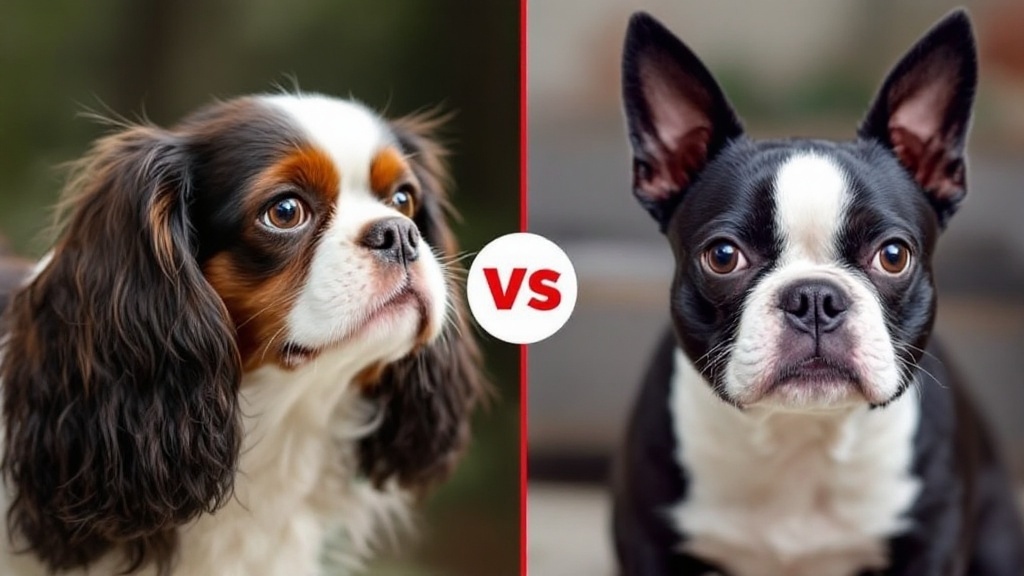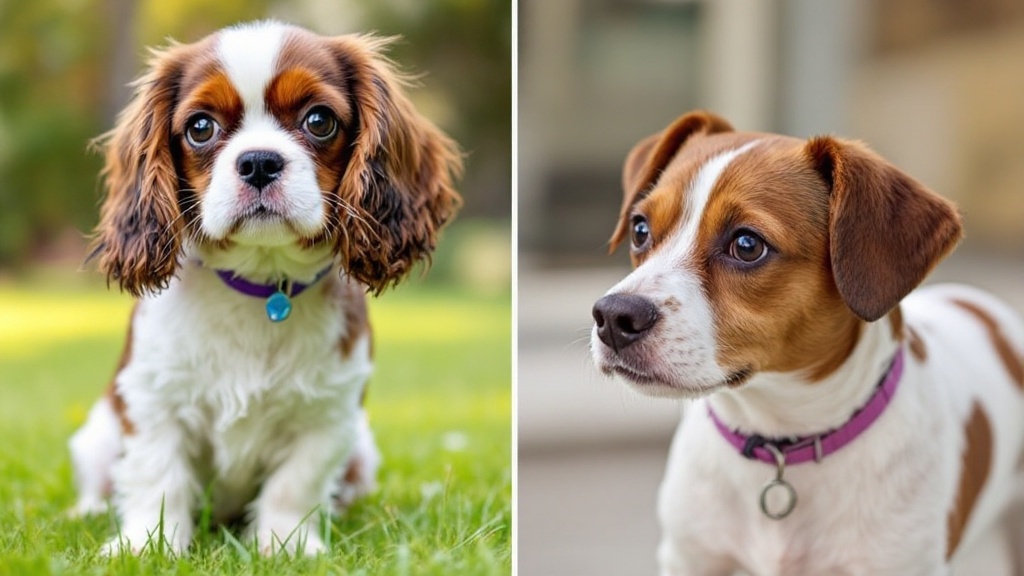If you’re choosing between a Cavalier King Charles Spaniel and an English Cocker Spaniel, it helps to know their main differences.
The Cavalier is smaller, gentler, and usually better for a calm indoor life. The English Cocker Spaniel is bigger, more energetic, and needs more exercise. That’s a pretty big deal if you’re trying to match a dog to your lifestyle.
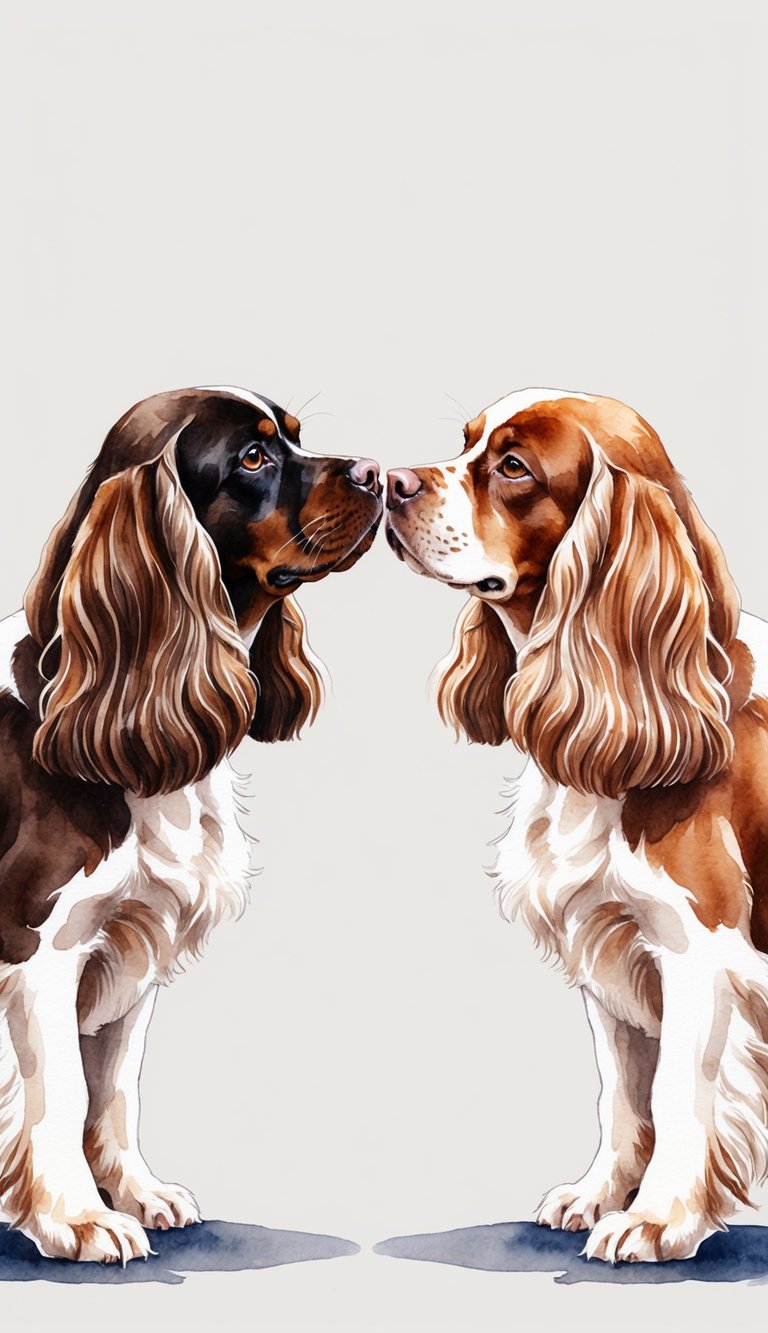
Both breeds have sweet personalities but their energy and looks are pretty different.
The Cavalier has a soft, silky coat and a delicate, almost plush appearance. The English Cocker looks sportier, with a thicker, wavy coat.
How much grooming and activity you want to handle will probably steer your decision.
This comparison will break down their size, temperament, care needs, and health. Hopefully, you’ll get a clearer sense of which spaniel matches your home and routine.
Key Takeways
- One breed is better for calm, indoor living; the other needs more exercise and space.
- Their grooming needs and appearance differ significantly.
- Health and personality traits vary, affecting care and training.
Breed Origins and History
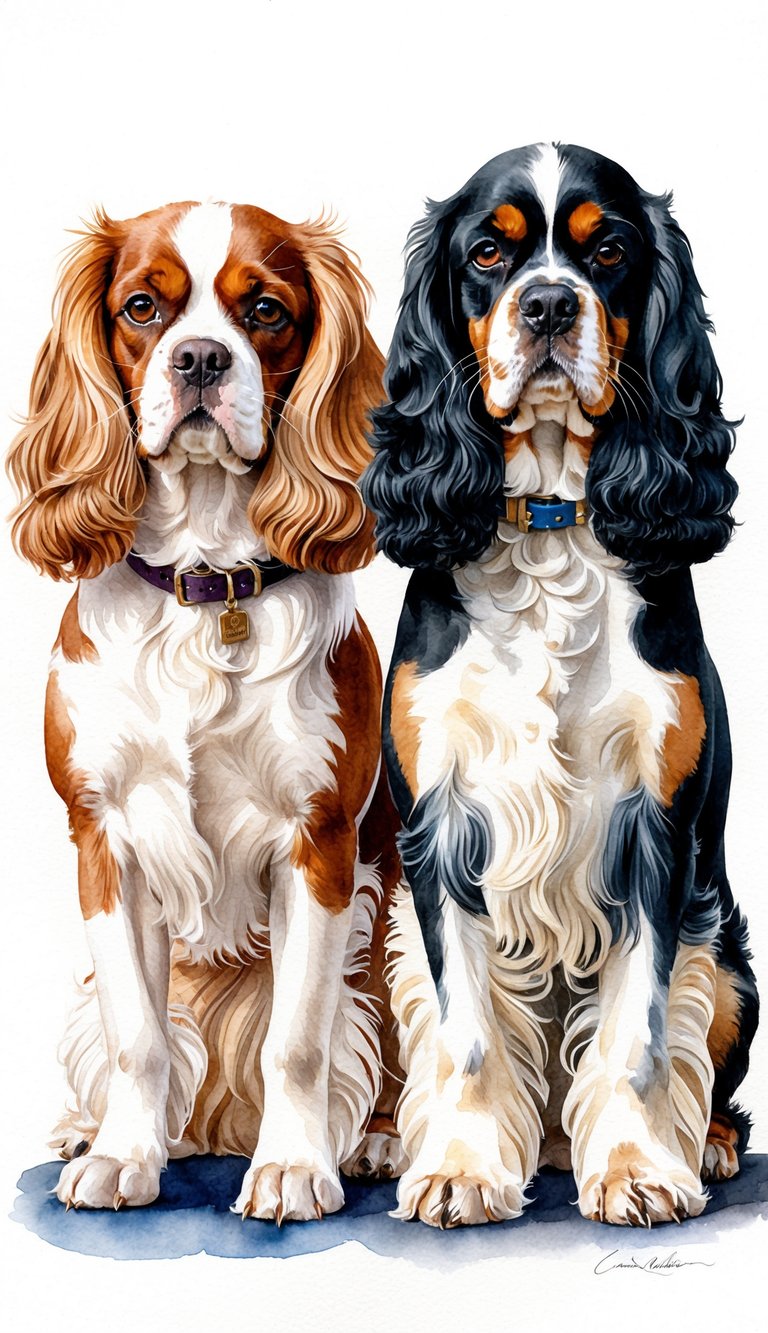
These two spaniel breeds came from different times and had different jobs.
One breed was mostly a royal pet. The other was bred for hunting and work.
Both have deep backgrounds tied to their skills and the people who raised them.
Cavalier King Charles Spaniel Background
The Cavalier King Charles Spaniel traces back to 16th and 17th-century English lap dogs.
King Charles II adored small spaniels, often keeping them close. The breed’s name comes from him, and these dogs were meant as gentle companions.
In the 20th century, breeders worked to restore the look seen in old paintings. They wanted friendly, elegant pets rather than hunting dogs.
That’s probably why Cavaliers tend to have such a calm, affectionate vibe.
English Cocker Spaniel Background
English Cocker Spaniels come from a long line of hunting dogs bred to flush out birds.
They first appeared as distinct dogs in England in the late 1800s.
The name “Cocker” actually refers to their skill in hunting woodcock, a type of game bird.
They were bred to work in fields and forests, showing off their energy and strong noses.
Even as family pets, they keep that working-dog spark. If you have an English Cocker Spaniel, you’ll probably notice that hunting spirit still today.
Development as Companion and Working Dogs
The Cavalier King Charles Spaniel was bred mostly as a companion dog.
It was meant to sit with you and offer comfort.
These dogs are generally smaller, quieter, and more suited to home life.
The English Cocker Spaniel was bred to be a working dog.
They need plenty of exercise and love outdoor activity.
Still, they work well as family pets, mixing energy with affection.
| Breed | Primary Role | Main Traits |
|---|---|---|
| Cavalier King Charles Spaniel | Companion | Affectionate, calm, elegant |
| English Cocker Spaniel | Working/Hunting | Energetic, alert, strong nose |
Physical Appearance Comparison
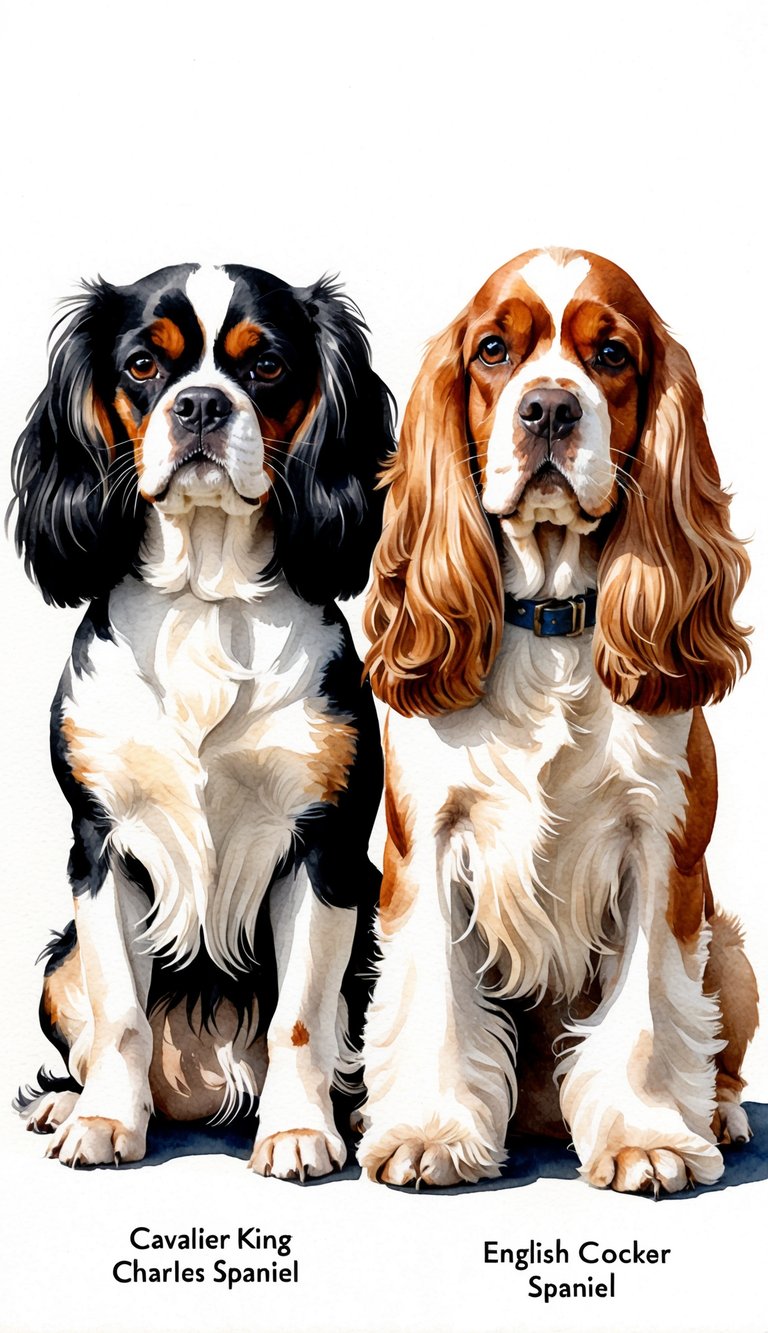
You can spot clear differences in size, coat, and facial features between the Cavalier King Charles Spaniel and the English Cocker Spaniel.
These details really help you tell them apart, and they might sway your choice.
Size and Build Differences
The Cavalier King Charles Spaniel is smaller and more delicate.
Cavaliers usually stand 12 to 13 inches tall at the shoulder and weigh 13 to 18 pounds. Their frame is light and graceful.
English Cocker Spaniels are taller and sturdier.
They usually measure 15 to 17 inches tall and weigh 26 to 34 pounds. Their bodies are more muscular and compact.
If you want a smaller, lighter dog, the Cavalier is the way to go. Prefer a stronger, more solid build? The English Cocker probably fits better.
Coat Types and Color Variations
The Cavalier King Charles Spaniel has a silky, medium-length coat that feels soft and smooth.
It lies flat with feathering on the ears, legs, and tail.
Colors include:
- Blenheim (chestnut and white)
- Tricolor (black, white, and tan)
- Black and tan
- Ruby (solid red)
The English Cocker Spaniel’s coat is thicker and a little wavy.
It’s longer on the ears, chest, belly, and legs.
You’ll see lots of colors and patterns:
- Solid black, liver, or red
- Parti-color (two or more colors)
- Roan (white mixed with color)
- Ticked or speckled patterns
If you love a silky smooth coat, think Cavalier. If you’re into more variety and texture, the English Cocker might win you over.
Distinctive Facial Features
The Cavalier King Charles Spaniel has large, dark eyes set wide apart.
Their eyes give off a soft, gentle look.
They have a flat face, short muzzle, and long, feathered ears that hang close to the head.
The English Cocker Spaniel has a slightly longer muzzle and a more square-shaped head.
Their eyes are smaller and set deeper, making them look alert and lively.
Their ears are also long but thicker and more heavily feathered.
These face shapes really change their expressions. The Cavalier looks sweet and soft, while the English Cocker has a more alert, energetic style.
Temperament and Personality Traits
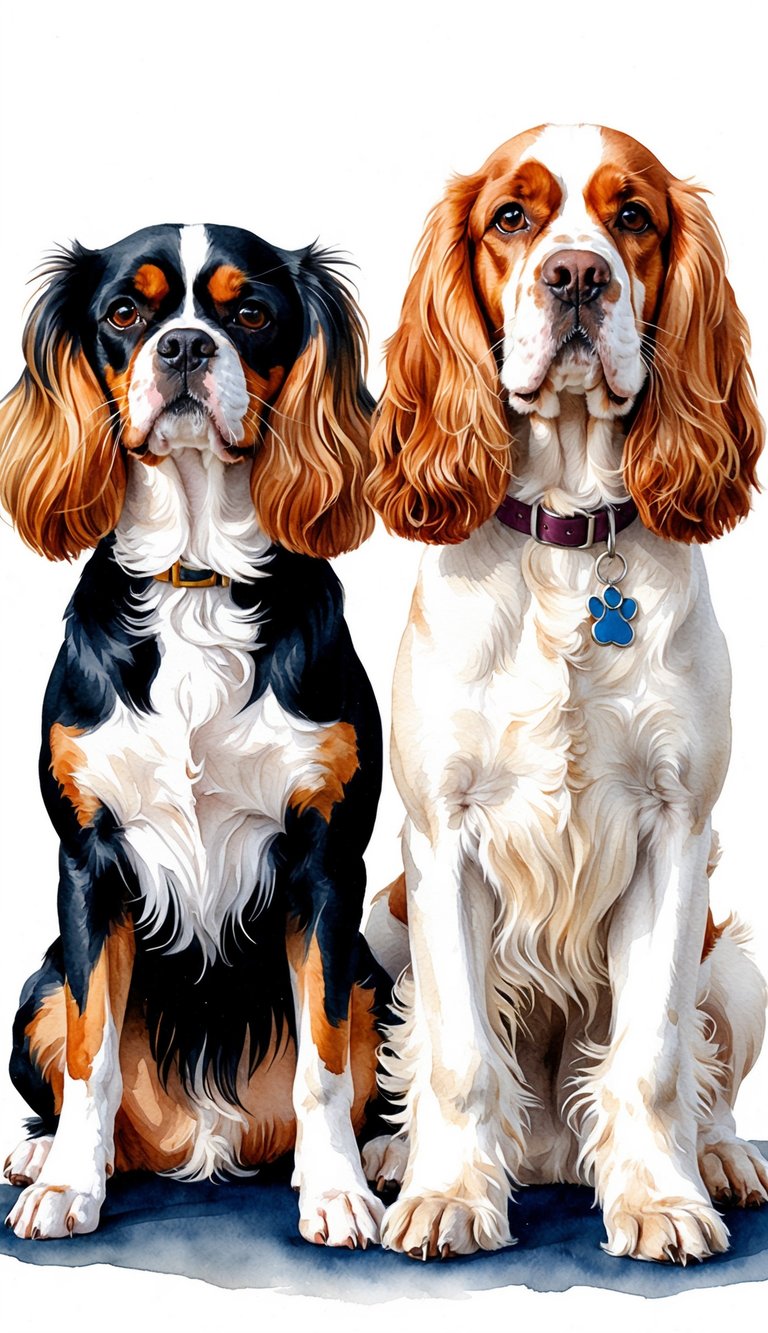
The Cavalier King Charles Spaniel and the English Cocker Spaniel each bring their own quirks to the table.
Their personalities shape how they act with people and other animals.
Knowing their social nature, energy, and family fit helps you pick the right dog for your own life.
Affectionate Nature and Social Behavior
The Cavalier King Charles Spaniel is famous for being super affectionate.
It loves to be near you, always ready for a cuddle or some attention.
This breed thrives on companionship and usually gets along well with kids and other pets.
Its gentle temperament makes bonding pretty easy.
English Cocker Spaniels are also affectionate, but it’s a little different.
They’re a bit more independent and can be aloof with strangers.
Still, they’re loyal and friendly with family.
With the right socialization early on, they’ll be outgoing and playful.
Both breeds love people, but Cavaliers usually need more close contact and reassurance.
If you’re home a lot, the Cavalier’s social needs might fit your routine better.
Prey Drive and Energy Levels
English Cocker Spaniels have a higher prey drive than Cavaliers.
They’ll chase small animals or anything that moves.
If you have a cat or small pets, you’ll need to keep an eye on things with a Cocker Spaniel.
Cockers are more active and need daily exercise.
They love long walks, playtime, and mental challenges.
Their hunting roots really drive that need for activity.
Cavalier King Charles Spaniels have a moderate energy level.
They’re happy with walks and play, but don’t demand as much.
Their lower prey drive means they’re calmer around smaller animals and less likely to chase.
So, if you’re active and want a dog that’ll keep up, the Cocker’s for you. If you prefer a laid-back companion, the Cavalier is probably your match.
Suitability as Family Pets
Both breeds make good family pets, but their needs aren’t the same.
Cavaliers are a great fit for families wanting a calm, affectionate dog.
They do well with kids and can handle both quiet and busy homes.
English Cocker Spaniels are better for families who can give more exercise and structured training.
They need mental and physical outlets to avoid getting bored or acting out.
If you’ve got young kids, Cavaliers might be the safer bet because of their gentle nature.
Cockers need more supervision and consistent training.
| Trait | Cavalier King Charles Spaniel | English Cocker Spaniel |
|---|---|---|
| Affection Level | Very high, seeks closeness | High, but slightly more reserved |
| Prey Drive | Low | High |
| Exercise Needs | Moderate | High |
| Best for Families | Calm, affectionate settings | Active families with training |
Pick the breed that lines up with your lifestyle, attention level, and the kind of activity you want to provide.
Trainability and Intelligence
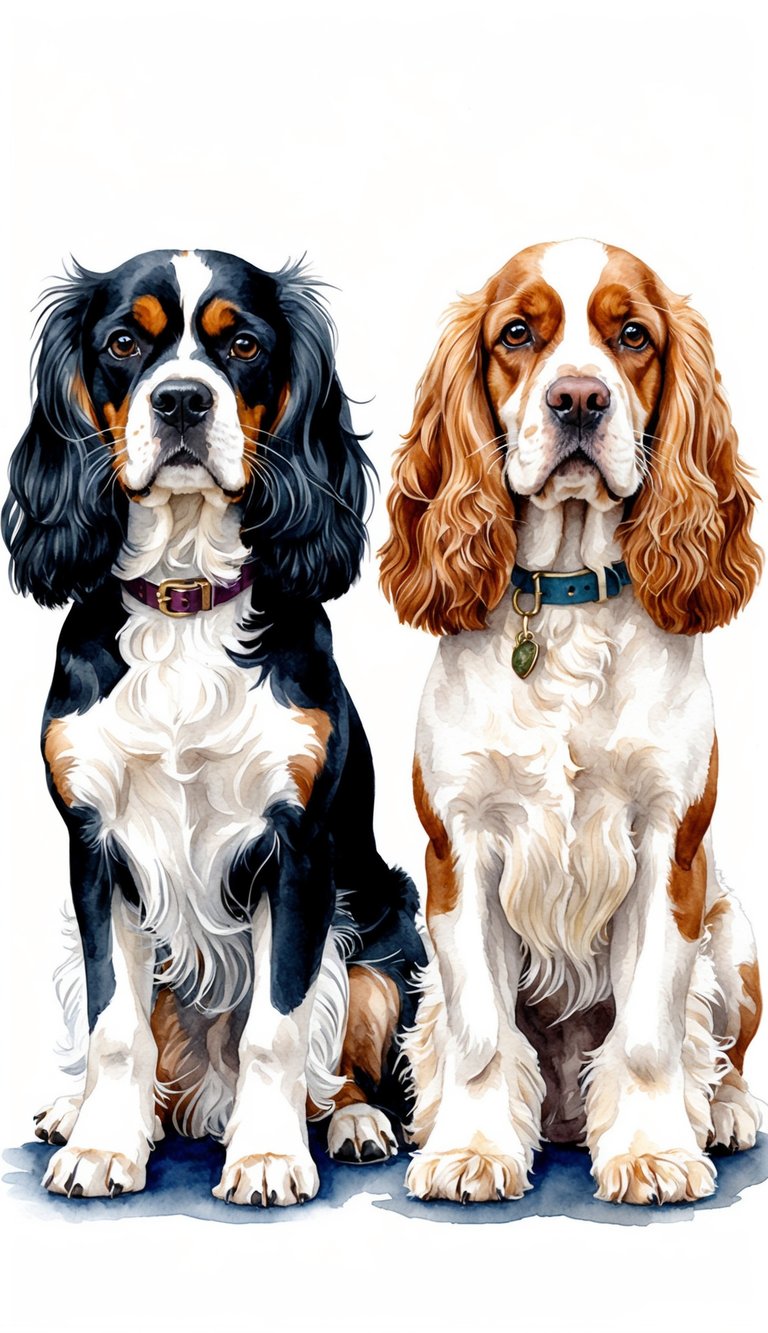
Both breeds respond well to training, but their strengths aren’t quite the same.
The English Cocker Spaniel picks up commands quickly. The Cavalier King Charles Spaniel learns steadily, especially with patience.
Their problem-solving skills and adaptability also differ, which changes how you might want to train them.
Obedience Training
The English Cocker Spaniel is usually easier to train than the Cavalier.
Cockers are eager to learn both basic and advanced commands.
They often do well in obedience trials, a little like Labradors or Standard Poodles.
Cavaliers can be more sensitive and sometimes get distracted, so training sessions should be short and upbeat.
They like gentle encouragement, but usually take a bit longer to pick up new things compared to Cockers.
Consistent routines and rewards (treats or praise) work best for both.
Skip harsh corrections, especially with Cavaliers—they’ll lose trust and motivation.
Problem Solving and Adaptability
English Cocker Spaniels tend to be curious and quick to solve simple puzzles.
They adapt fast in new places or around new people, kind of like Border Collies or Miniature Schnauzers.
Cavaliers are less independent and lean on humans when facing challenges.
They might be slower to figure things out solo, but that can make them easier to guide.
Cockers adjust well to change and stay focused, while Cavaliers prefer familiar routines.
It’s good to keep this in mind when planning training and daily activities.
Exercise Needs and Activity Levels
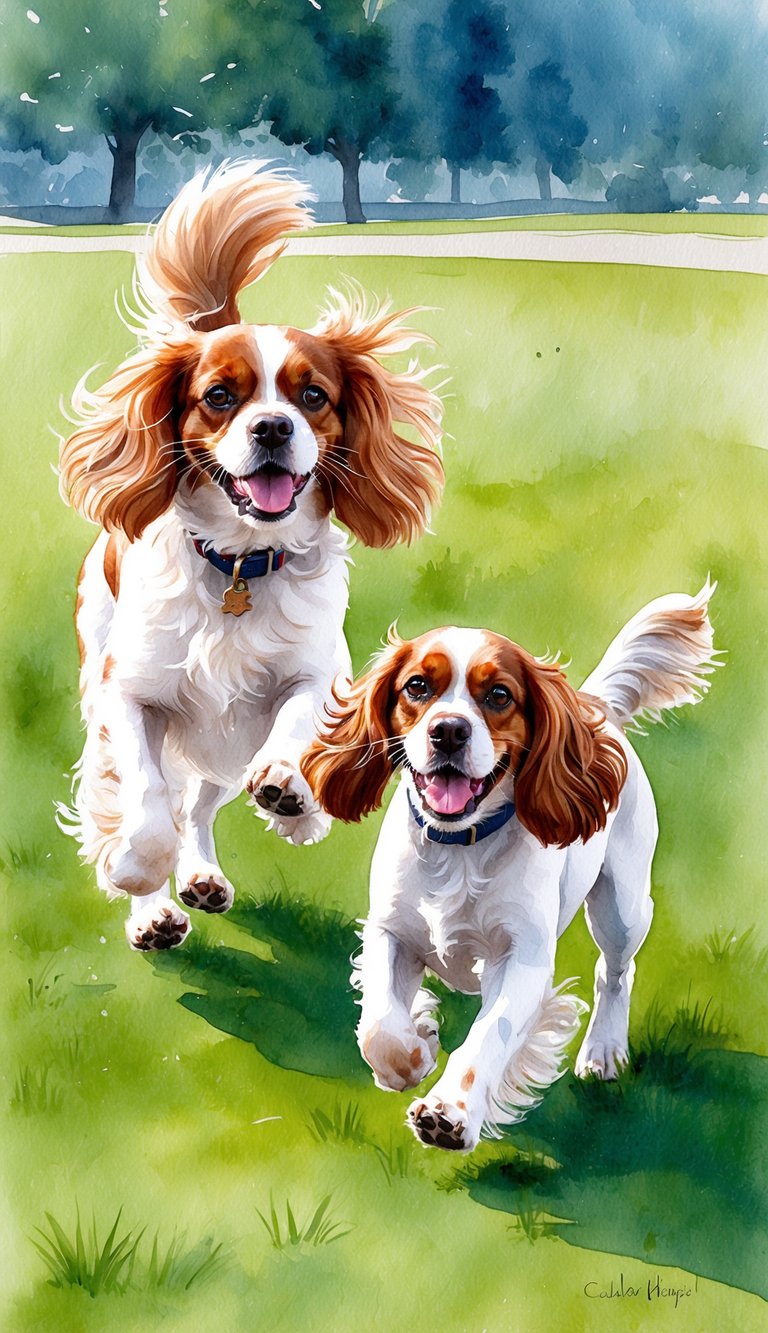
Both Cavalier King Charles Spaniels and English Cocker Spaniels need regular activity to stay healthy.
Their energy and exercise needs aren’t the same, so you’ll want to plan routines that fit each breed’s natural style.
Daily Physical Requirements
The English Cocker Spaniel packs a lot of energy. Plan for at least 60 minutes of exercise every day.
This can mean brisk walks, running, or just tossing a ball around. They were bred as hunting companions, so they really love activities that let them use their energy and agility.
The Cavalier King Charles Spaniel is more laid-back. Usually, 30 to 45 minutes of gentle walks or play does the trick.
They’re content with lighter activity and don’t crave intense workouts. Both breeds get a boost from outdoor time.
Regular movement helps keep their weight in check and muscles in good shape.
Mental Stimulation and Enrichment
Mental exercise matters for both breeds. The English Cocker Spaniel is sharp and loves training games, puzzle toys, and scent work.
These activities tap into their hunting instincts and keep them thinking. The Cavalier is happy with simpler stuff—basic obedience, gentle interactive play, or a new toy.
Treats and praise go a long way in training. Switching up their routine with new places or meeting new dogs keeps things interesting.
If they don’t get enough mental stimulation, you might see anxiety or barking.
Grooming and Maintenance
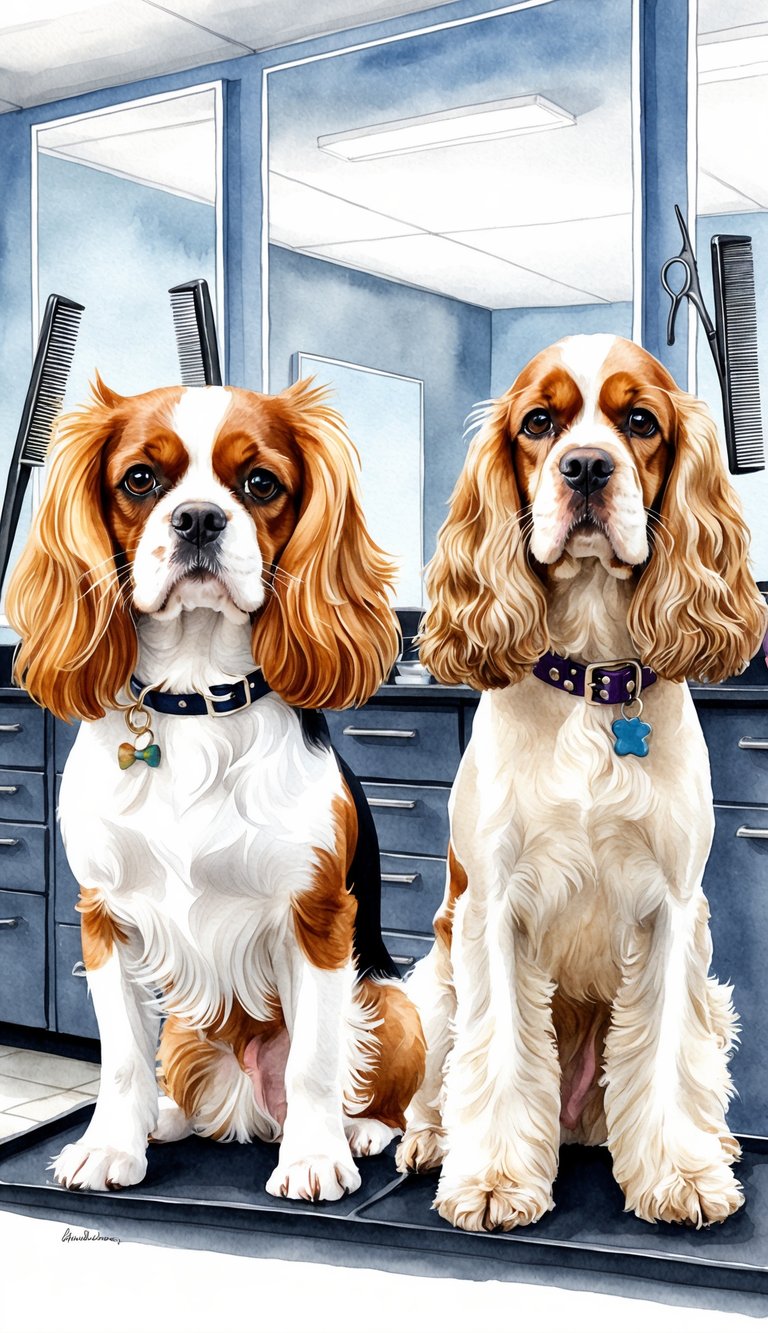
Both breeds need regular care to stay comfortable. Expect to spend time brushing and checking their ears and skin.
Frequent grooming helps prevent mats and infections.
Shedding and Brushing
The Cavalier King Charles Spaniel sheds a moderate amount. You’ll want to brush them at least three times a week.
A slicker brush or comb works well to remove loose hair and stop mats, especially behind the ears and chest. The English Cocker Spaniel’s thicker, wavy fur tangles easily.
Daily brushing is best for Cockers. Their longer feathering on the legs and belly needs extra attention.
Unlike breeds like the Bichon Frise or Maltese, these Spaniels mostly need brushing, not full haircuts. Some trimming around the paws and sanitary areas helps keep things tidy.
Ear and Skin Care
Both breeds have floppy ears that trap moisture. Check their ears weekly for redness, odor, or discharge.
Clean gently with a vet-approved solution. Skin problems can pop up, especially if mats form or ears stay damp.
Cavaliers are prone to allergies, so watch for itching or redness. Cockers need skin checks, too—their thick coat can hide hot spots.
Consistent grooming cuts down on issues often seen in similar-coated breeds like Shih Tzus. Stick with regular ear cleaning and coat care for healthy skin.
Health and Common Medical Issues
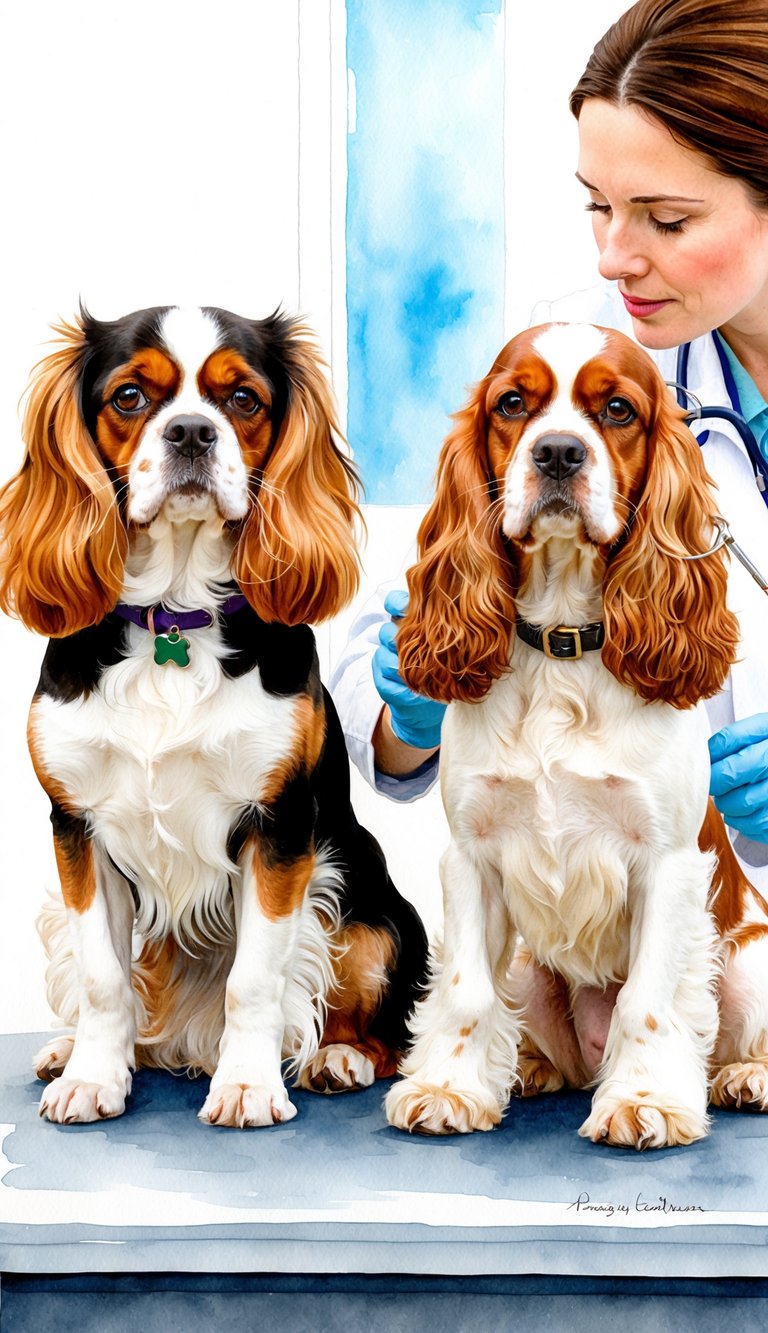
Both breeds come with their own set of health concerns. Knowing what to watch for, and focusing on preventive care, can help your dog stay healthier, longer.
Inherited Genetic Conditions
The Cavalier King Charles Spaniel often deals with mitral valve disease. This heart issue can get worse over time and may lead to heart failure.
They also risk syringomyelia, a painful nervous system disorder caused by fluid-filled cavities in the spine. English Cocker Spaniels face eye problems like progressive retinal atrophy (PRA) and cataracts, which can cause vision loss if left untreated.
They can inherit hip dysplasia, too. Genetic testing before breeding helps lower these risks.
Ask breeders for health clearances to protect your pup from inherited diseases.
Lifespan and Longevity
Cavalier King Charles Spaniels usually live 9 to 14 years. Heart disease or syringomyelia can shorten their lifespan.
English Cocker Spaniels tend to live 12 to 15 years. Eye problems and hip issues can affect how long they live.
Regular vet visits help catch illness early. Quick treatment can make a big difference in their quality of life.
Preventative Healthcare
Set up yearly health screenings for your spaniel. Cavaliers especially need heart checks—watch for breathing trouble or coughing.
Cockers benefit from regular eye exams to catch cataracts or PRA. Joint checks help spot hip dysplasia.
Vaccinations, dental care, and a good diet all support their health. Keeping them active and at a healthy weight eases stress on joints and the heart.
Living Environment and Owner Suitability

Both the Cavalier King Charles Spaniel and the English Cocker Spaniel adapt well to different living spaces. Your lifestyle and household shape which breed fits best, especially if you have other pets or kids.
Ideal Home Setting
If you live in an apartment or a smaller house, the Cavalier King Charles Spaniel is usually the better pick. They need less exercise and handle limited space well.
They still need daily walks and play, though. The English Cocker Spaniel needs more room to burn off energy.
A house with a yard suits them best. Owners who like to stay active or have a yard will find the Cocker a better match.
Both breeds enjoy being indoors but love outdoor time. If you already have a Bernese Mountain Dog or Boston Terrier, both spaniels usually get along thanks to their friendly personalities.
Compatibility with Children and Other Pets
The Cavalier King Charles Spaniel is gentle and patient. They’re great with children and smaller pets like Papillons or Havanese.
They tend to stay calm and don’t overwhelm little kids. The English Cocker Spaniel does well with children, too, but can be a bit more energetic or rowdy.
They get along with family pets, including French Bulldogs, if they’re socialized early. Both breeds do best when families supervise play with young kids and pets to avoid accidental roughhousing.
Considerations for First-Time Owners
If you’re new to dog ownership, the Cavalier King Charles Spaniel is usually easier. Their calm nature and smaller exercise needs make things less overwhelming.
They need regular grooming but are pretty easygoing otherwise. The English Cocker Spaniel needs more consistent training and lots of activity.
Be ready for daily exercise and mental challenges to keep them happy. Both breeds benefit from early socialization.
The Cavalier is often the go-to for first-timers, while the English Cocker fits best with owners ready for a hands-on, active companion.
Comparison With Similar Dog Breeds
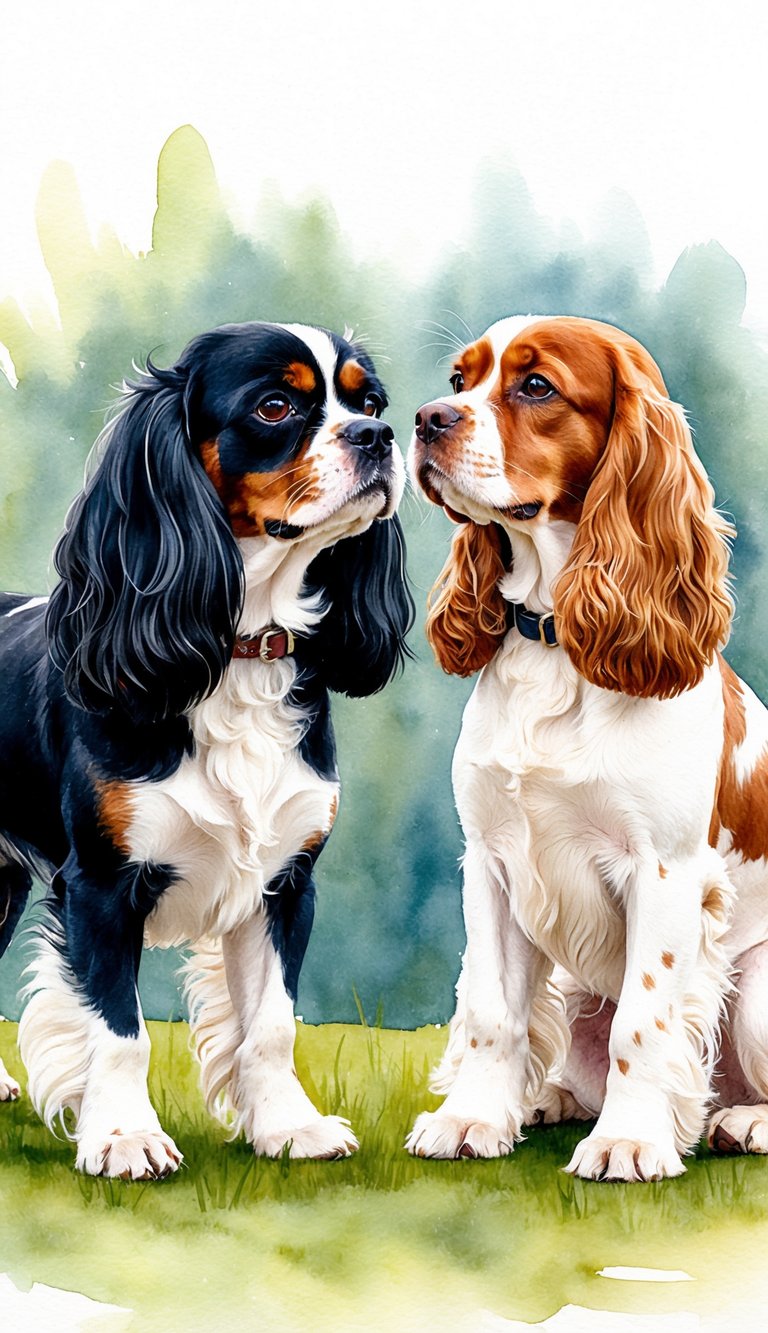
When you compare the Cavalier King Charles Spaniel and English Cocker Spaniel, it helps to look at other breeds with similar roles or sizes. Some breeds are all about companionship, while others lean into sporting or working.
Toy and Companion Breeds
If you’re looking for a smaller, companion-focused dog, check out the Toy Poodle, Shih Tzu, or Maltese. These breeds are gentle and need regular grooming, much like the Cavalier.
The Bichon Frise and Havanese are friendly and don’t need tons of exercise. The Papillon is tiny but lively—maybe a bit more demanding mentally.
If you want a sturdier toy breed, compare the Cavalier to the Boston Terrier or French Bulldog. They have different grooming needs and a unique look.
Other Sporting and Working Breeds
For more active homes, the English Cocker Spaniel lines up with breeds like the Labrador Retriever, Border Collie, or Standard Poodle. These dogs thrive on exercise and mental challenges.
The Miniature Schnauzer brings energy and alertness in a smaller package. Breeds like the Collie and Bernese Mountain Dog are bigger, need more space, and take more time but share those working roots.
They shine in jobs that demand stamina and smarts—very different from the easygoing spaniel vibe.
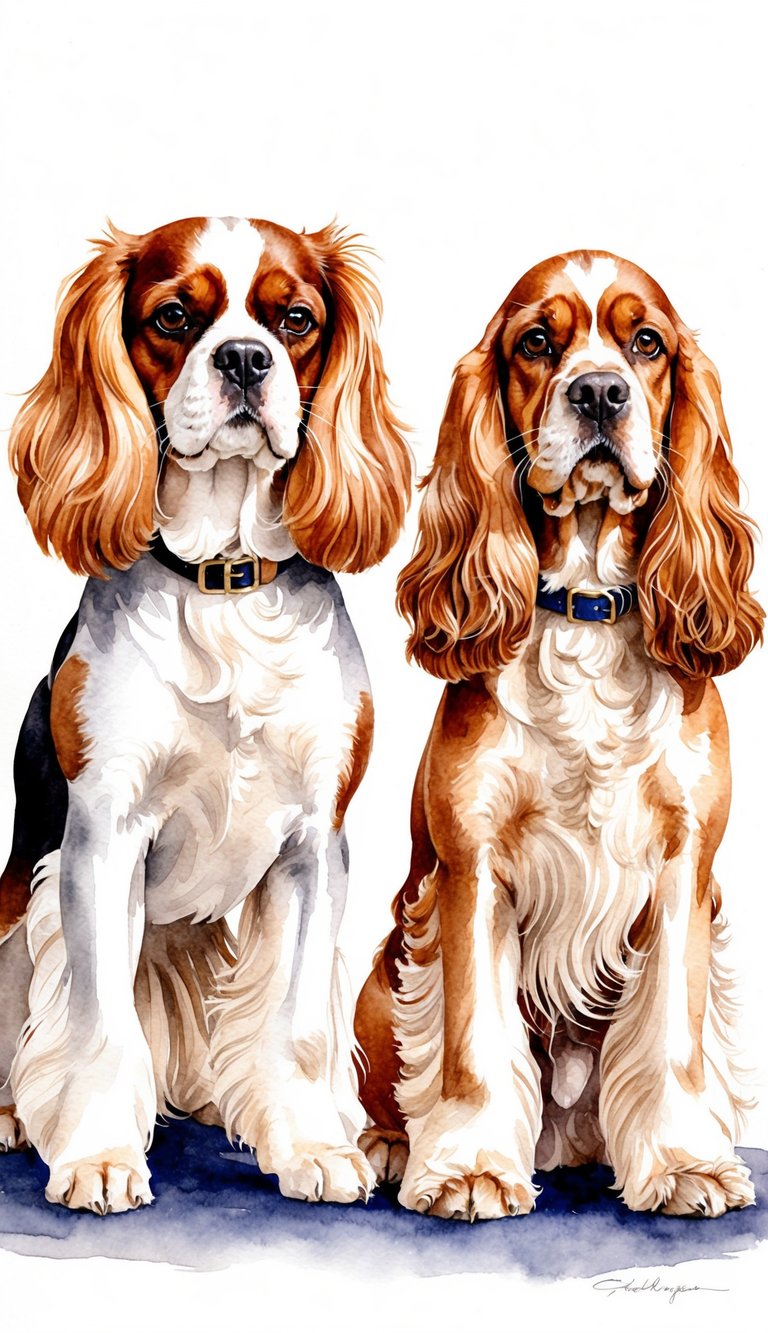
So, you’re looking at two classic spaniels: the Cavalier King Charles Spaniel and the English Cocker Spaniel. Both breeds bring friendliness and charm to the table, but they’re not quite the same.
The Cavalier is smaller and, honestly, just a bit more chill. It’s perfect if you’ve got a cozy apartment or you just want a lapdog who loves to snuggle.
On the other hand, the English Cocker Spaniel packs more energy. This dog needs regular exercise and a bit of a challenge to stay content.
| Trait | Cavalier King Charles | English Cocker Spaniel |
|---|---|---|
| Size | Small | Medium |
| Energy Level | Low to moderate | Moderate to high |
| Grooming Needs | Moderate | Moderate to high |
| Temperament | Calm, affectionate | Playful, energetic |
Take a second to think about your daily routine and the space you have. It really does make a difference.
Both breeds give back tons of love and loyalty. With some care and attention, either one could easily become your new favorite family member.

